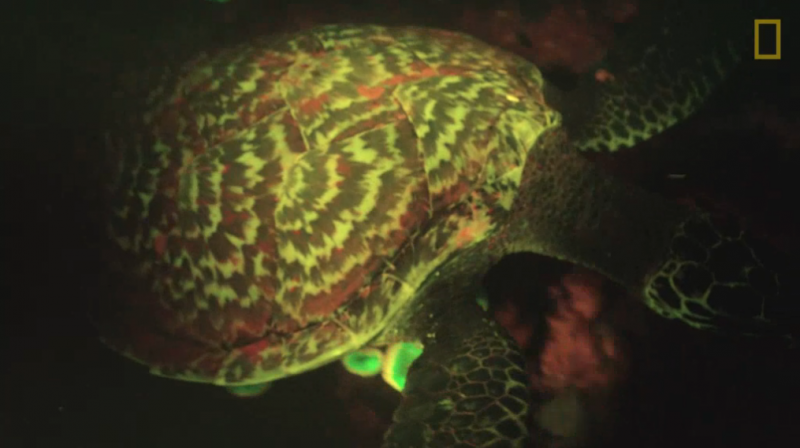September 30, 2015 weblog
Glowing sea turtle, like red and green spaceship, spotted

Seen off the Solomon Islands: The hawksbill sea turtle—glowing. Sharks, fish, corals, can shine and now we know that the sea turtle can too. Jane J. Lee reported on Tuesday in National Geographic (and environmental news site Mongabay also carried the news) that a biofluorescent sea turtle was discovered off the coast of Solomon Islands.
Dozens of fish and shark species do it; the turtle came as a surprise. These animals light up due to unique structures in their skin which enable them to biofluoresce, said Lee. The definition is given as "the ability to reflect the blue light hitting a surface and re-emit it as a different color," such as green, red or orange.
Lee wrote that "the marine biologist captured the turtle sighting on a video camera system, whose only artificial illumination was a blue light that matched the blue light of the surrounding ocean. A yellow filter on the camera allowed the scientists to pick up fluorescing organisms."
According to National Geographic, the critically endangered hawksbill sea turtle is the first reptile scientists have seen exhibiting biofluorescence. According to Mongabay, David Gruber, a marine molecular biologist at City University of New York, said he made the discovery mostly by accident while filming biofluorescent coral off the Solomon Islands coast —the glowing sea turtle swam right by him.
Gruber's encounter was recorded in a video, showing when he saw the turtle. "Scientists have only tuned in to bioflourescence in the last ten years and as soon as we started tuning into it we found it everywhere."
He compared the sight of the glowing sea turtle to "a bright red and green spaceship, underneath my camera." The turtle was very calm and appeared to "hang" out with Gruber and team.
One point about bioflourescence in general is that these creatures are using light in a way we do not see. "It's a hidden world that we're just now beginning to tune into," Gruber, said in an earlier National Geographic interview.
Why would the sea turtle have developed biofluorescence? It's too early to say for sure. The sea turtle was glowing neon green and red. The discovery nonetheless turns up questions in search of answers. Why do the turtles have this feature? How are they using this feature? "We know that the sea turtle has really good vision," commented Gruber," and they go on long and arduous migrations." Are they using this feature to find each other? To attract each other? Still other questions as noted in the National Geographic article which Gruber wants to explore: can these turtles see the biofluorescence; do they take in compounds from their food that let them fluoresce, or do they make their own compounds?
Another noteworthy point about these sea turtles: they are critically endangered. Quoted in National Geographic, Gruber said, "It'd be fairly difficult to study this turtle because there are so few left and they're so protected." Their population numbers have declined by almost 90 percent in recent decades. Hawksbill sea turtles are in turn one of the rarest species on our planet, he said, and the animals remain a mystery.
© 2015 Phys.org




















